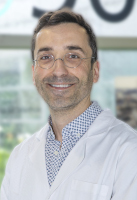 ENTRY-DM is an MSCA* multidisciplinary doctoral network aimed at developing oligonucleotide-based therapies and preparing clinical trials in myotonic dystrophy, through advanced doctoral training. It brings together 11 European laboratories and 18 international partners with expertise in disciplines as varied as medicinal chemistry, genetics, multi-omics, bioengineering and neuropsychology. Interview with the project coordinator, Mario Gomes-Pereira, a researcher in the REDs laboratory at the Institute’s Center for Research in Myology.
ENTRY-DM is an MSCA* multidisciplinary doctoral network aimed at developing oligonucleotide-based therapies and preparing clinical trials in myotonic dystrophy, through advanced doctoral training. It brings together 11 European laboratories and 18 international partners with expertise in disciplines as varied as medicinal chemistry, genetics, multi-omics, bioengineering and neuropsychology. Interview with the project coordinator, Mario Gomes-Pereira, a researcher in the REDs laboratory at the Institute’s Center for Research in Myology.
What was the background to the creation of this network?
A few years ago, at an ENMC workshop, we got together with around fifteen European researchers from different specialities working on DM1, discussing how we could strengthen the links between us by creating a collaborative network backed by European funding. We then decided to apply to this competitive call for tenders, organised each year by the European Commission, for the training and mobility of doctoral students.
What is ENTRY-DM?
Between 2025 and 2029, this project aims to train around fifteen PhD students in translational research into DM1, by combining fundamental and clinical skills in several disciplines, in the academic, industrial and regulatory fields. Its aim is to develop oligonucleotide-based therapies for this disease and prepare clinical trials to test them.
Students will be hosted in 11 laboratories for the duration of their thesis, and will complete their training with two 3-month internships offered by all the associated partners. These internships, which may take place in academic or non-academic institutions, will provide them with additional training in a variety of sectors, fostering the acquisition of interdisciplinary and cross-sectoral skills, and thus preparing them for the job market in diversified professional environments. The partners can take part in workshops or seminars (on intellectual property, clinical trial regulations, etc.), or host doctoral students for 3-month placements.
At the Institute, Jean-Yves Hogrel will supervise a student from Spain working in his Neuromuscular physiology and evaluation laboratory for 3 months. At the end of their PhD, the students, who will need to think about their career plans, will be able to join an academic, industrial or pharmaceutical laboratory, or a regulatory agency.
Where is the Institute of Myology involved?
At an administrative level, I’m the network coordinator and therefore responsible for the scientific coordination of the project. But I will also be supervising two students in my REDs team, with Geneviève Gourdon and Denis Furling, who will be working on identifying circulating biomarkers of DM1 muscle and brain pathologies. These biomarkers will play a key role in monitoring the progression of the disease and assessing the effectiveness of therapeutic interventions. Nathalie Angeard, who is co-leader of the Psychology and Neuropsychology team, will supervise a student to work on DM1 patients’ decision-making and their motivation to take part in a clinical trial.
What are the next steps?
We are going to launch the recruitment of doctoral students at European level (in particular via the Euraxess portal) from March 2025, with the aim of starting the theses in September 2025. Over the next 36 months, there will be regular meetings between all the participants and smaller workshops to encourage direct exchanges between young researchers, so that their projects can feed off each other. And that we fulfil the initial objective of this unique network: to foster synergies across Europe and ensure that it is the source of biomedical innovations that will improve patient care through future collaborations.
_______________
* Interdisciplinary doctoral training on oligonucleotide-based therapies for myotonic dystrophy – MARIE SKŁODOWSKA-CURIE ACTIONS (MSCA) Doctoral Networks (DN).
** The countries concerned are Spain, the Netherlands, Italy, Germany, Poland and France, where three laboratories are involved: Nathalie Angeard from the Institute of Myology’s Psychology and Neuropsychology team, Mario Gomes-Pereira and the REDs team from Center of Research in Myology of the Institute of Myology, and Cécile Martinat from I-STEM.
